Enhanced Retention and Synergistic Plugging Effect of Multi-Complexed Gel on Water-Swellable Rubber
Abstract
1. Introduction
2. Experimental Part
2.1. Experimental Materials
2.2. Synthesis of Multi-Component Complex Gel Cross-Linking Agent
2.3. Synergistic Plugging Experiment of Multi-Complexed Gel and Water Swellable Rubber
2.3.1. Research on Plugging Rate and Erosion Resistance
2.3.2. Study on the Influence of Residual Oil Distribution in Fractured Channels
2.3.3. Evaluation of Water Cut and Recovery Factor
3. Results and Discussions
3.1. Influencing Factors of Multi-Complex Gel System Gelation
3.2. Study on Enhanced Retention Mechanism
3.3. Research on Collaborative Plugging Mechanism
4. Conclusions
- (1).
- In view of the disadvantage of water-swelling rubber not being resistant to erosion, a multiple-complex polymer gel was developed to enhance the plugging effect. The multi-component complex gel crosslinker was synthesized and its specific application range was determined; polymer concentration was 1500 mg/L~3000 mg/L, polymer cross ratio was 30:1, pH value was 7–9 and temperature was 30–60 °C.
- (2).
- The enhanced retention mechanism of the mult1i-component complexing gel and water-swelling rubber results from the Cr3+ encapsulated in the gel gradually cross-linking with the granular gel in the polymer to form a reticular spatial structure. As time goes on, this structure will become more and more uniform and stable without a large number of granular gels, and the gelling effect after waiting is obviously higher than that without waiting. Therefore, this structure can completely play the role of sealing the formation.
- (3).
- It is confirmed that the plugging performance of the combination of water-swelling rubber particles and multi-component complex polymer gel is better than that of the single injection of particles, and the erosion resistance is improved. The oil displacement ability of this system was further confirmed by the saturated oil experiment of with flat core. Through the water content and oil recovery experiments, it was confirmed that the optimal injection concentration of water-swelling rubber particles in this system is 3000 mg/L.
Author Contributions
Funding
Data Availability Statement
Conflicts of Interest
References
- Xie, K.; Cao, W.; Lu, X.; Song, K.; Liu, Y.; Zhang, Y.; Liu, J.; Lv, J.; Wang, W.; Na, R. Influence of water dilution on performance of chromium polymer weak gel in porous medium. J. Dispers. Sci. Technol. 2020, 41, 1549–1558. [Google Scholar] [CrossRef]
- Williamson Nathan, H.; Dower April, M.; Codd Sarah, L.; Broadbent Amber, L.; Gross, D.; Seymour Joseph, D. Glass Dynamics and Domain Size in a Solvent-Polymer Weak Gel Measured by Multidimensional Magnetic Resonance Relaxometry and Diffusometry. Phys. Rev. B Condens. Matter Mater. Phys. 2019, 122, 068001. [Google Scholar] [CrossRef] [PubMed]
- Xiao, L.; Lin, W.; Xiao, H.; Yong, X. Factors Influencing Viscosity of Twin-Tail Hydrophobically Associating Polymer Weak Gel. Appl. Mech. Mater. 2014, 3436, 98–101. [Google Scholar]
- Chuan, Z. Identification and quantitative description of large pore path in unconsolidated sandstone reservoir during the ultra-high water-cut stage. J. Pet. Sci. Eng. 2014, 122, 10–17. [Google Scholar] [CrossRef]
- Zheng, X.; Liu, M. Discussion on inverse lotion polymerization process of polyacrylamide. J. Putian Univ. 2014, 7, 68–71. [Google Scholar]
- Zhang, L.; Pu, C.; Yang, J. Application of graft copolymer of ultra-fine cellulose and acrylamide in profile control and water plugging. Oilfield Chem. 2015, 32, 503–506. [Google Scholar]
- Mack, J.C.; Smith, J.E. In depth colloidal dispersion gels improve oil recovery efficiency. J. Geosci. Res. Northeast. Asia 2000, 2, 207–209. [Google Scholar]
- Zhang, H.; Nikolov, A.; Wasan, D. Enhanced oil recovery (EOR) using nanoparticle dispersions: Underlying mechanism and imbibition experiments. Energy Fuels 2014, 28, 3002–3009. [Google Scholar] [CrossRef]
- Behrens, E.J. Investigation of Loss of Surfactants during Enhanced Oil Recovery Applications Adsorption of Surfactants onto Clay Materials. Master’s Thesis, Norwegian University of Science and Technology, Trondheim, Norway, 2013. [Google Scholar]
- Yu, S.; Guangsheng, C.; Tianyue, G.; Zhe, L.; Yujie, B.; Dan, L.; Zihang, Z. Development of gelled acid system in high-temperature carbonate reservoirs. J. Pet. Sci. Eng. 2022, 216, 110836. [Google Scholar]
- Abu-Abdeen, M.; Elamer, I. Mechanical and swelling properties of thermoplastic elastomer blends. Mater. Des. 2010, 31, 808–815. [Google Scholar] [CrossRef]
- Choi, S.S.; Ha, S.H. Water swelling behaviors of silica-reinforced NBR composites in deionized water and salt solution. J. Ind. Eng. Chem. 2010, 16, 238–242. [Google Scholar] [CrossRef]
- Snoeck, D.; Jensen, O.M.; Belie, N.D. The influence of superabsorbent polymers on the autogenous shrinkage properties of cement pastes with supplementary cementitious materials. Cem. Concr. Res. 2015, 74, 59–67. [Google Scholar] [CrossRef]
- Dehbari, N.; Tang, Y. Water swellable rubber composites: An update review from preparation to properties. J. Appl. Polym. Sci. 2015, 132, 42786–42797. [Google Scholar] [CrossRef]
- Zhang, Z.; Zhang, G.; Wang, C. Chlorohydrin water-swellable rubber compatibilized by an amphiphilic graft copolymer.III.Effects of PEG and PSA on water-swelling behavior. J. Appl. Polym. Sci. 2015, 79, 2509–2516. [Google Scholar] [CrossRef]
- Jia, H.; Ren, Q. Evidence of the gelation acceleration mechanism of HPAM gel with ammonium salt at ultralow temperature by SEM study. SPE Prod. Oper. 2016, 31, 238–246. [Google Scholar] [CrossRef]
- Xiao, Y.; Tao, Y.; Zhuhua, Z. Fly Ash-based Geopolymers: Effect of Slag Addition on Efflorescence. J. Wuhan Univ. Technol. (Mater. Sci.) 2016, 31, 689–694. [Google Scholar]
- Naghizadeh, A.; Ekolu, S.O. Method for comprehensive mix design of fly ash geopolymer mortars. Constr. Build. Mater. 2019, 202, 704–717. [Google Scholar] [CrossRef]
- Assi, L.N.; Deaver, E.; ElBatanouny, M.K. Investigation of early compressive strength of fly ash-based geopolymer concrete. Constr. Build. Mater. 2016, 112, 807–815. [Google Scholar] [CrossRef]
- Zhao, J.; Zhang, J.; Xiang, W.T. Distribution and presence state of polymer in porous media. J. China Univ. Pet. 2013, 37, 109–113. [Google Scholar]
- Wu, B.; Ma, X.; Zheng, Z. Weathering properties of alkali activated slag fly ash cementitious materials. Nonmet. Miner. 2020, 43, 6–10. [Google Scholar]
- Yu, S.; Guangsheng, C.; Tianyue, G.; Zihang, Z.; Yujie, B.; Jiajun, W.; Liming, Y. Evaluation of deep penetration of high-temperature sustained-release acid based on the reaction kinetics and conductivity of acid-etched fractures. Case Stud. Therm. Eng. 2022, 38, 102336. [Google Scholar]
- Lu, Z.J.; Lautru, J.; Zemb, T.; Rebiscoul, D. Colloidal sol of UO2 nanoparticles supported by multi-lamellar vesicles of carboxylate based surfactant. Colloids Surf. A Physicochem. Eng. Asp. 2020, 10, 125207. [Google Scholar] [CrossRef]
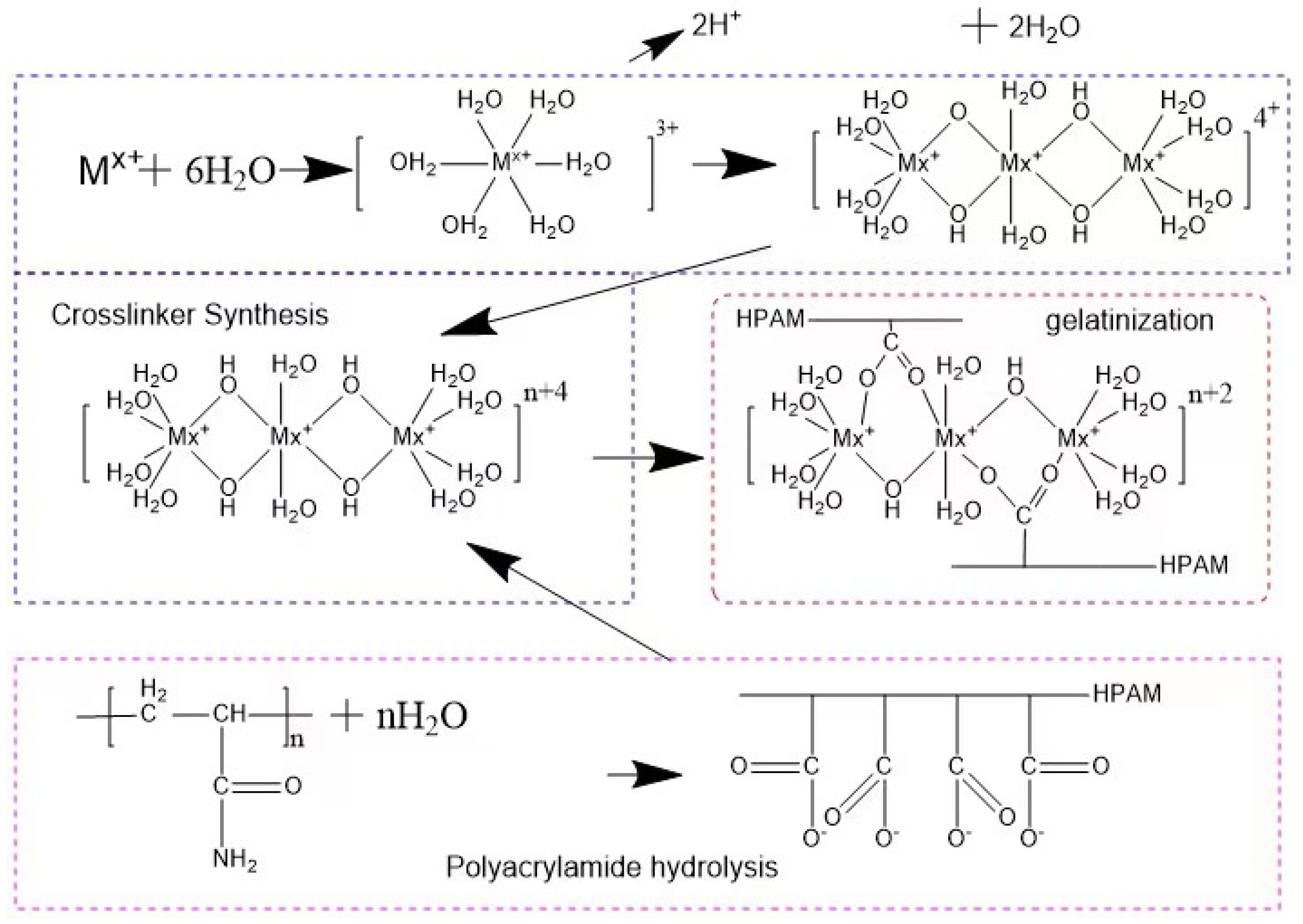

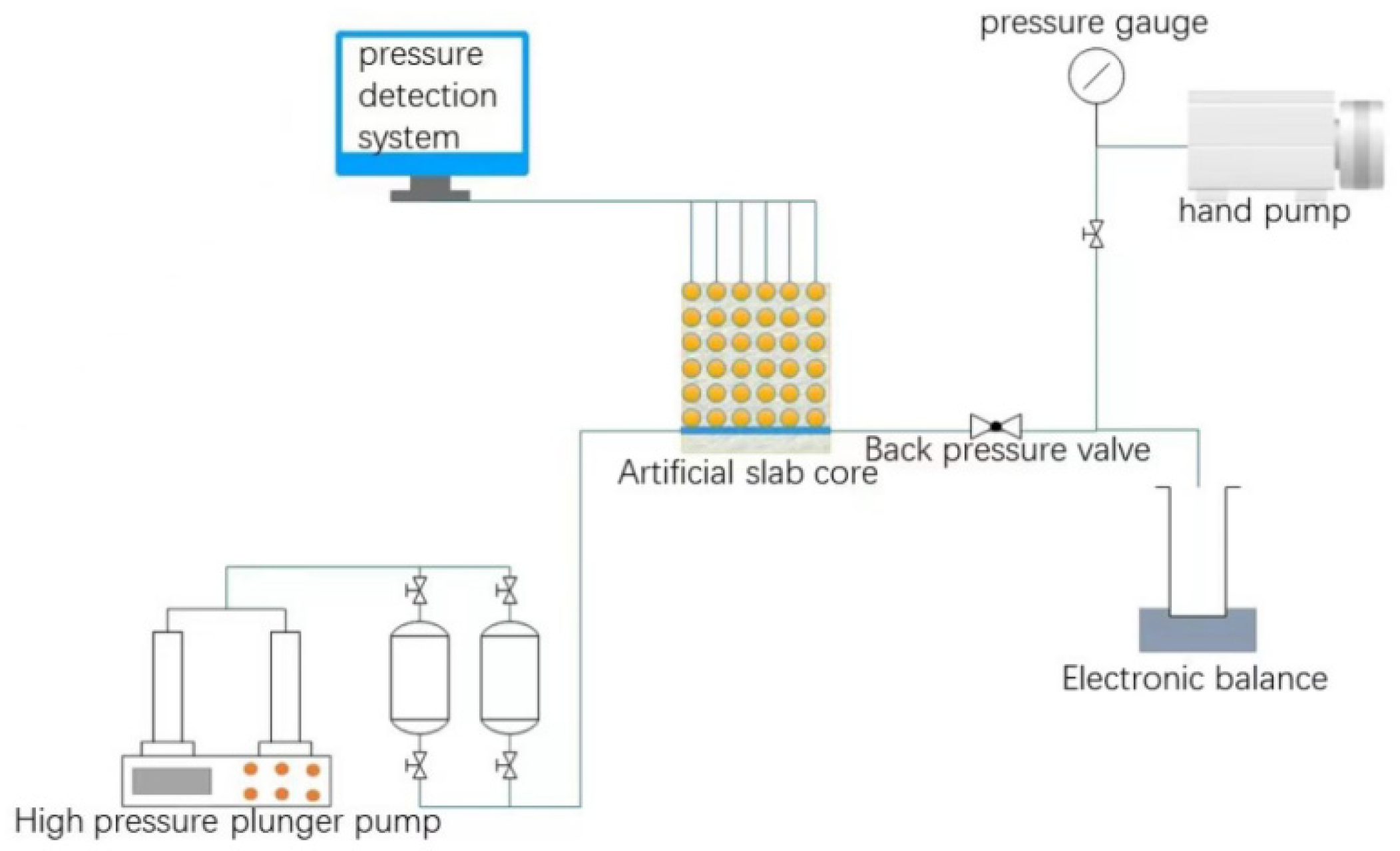
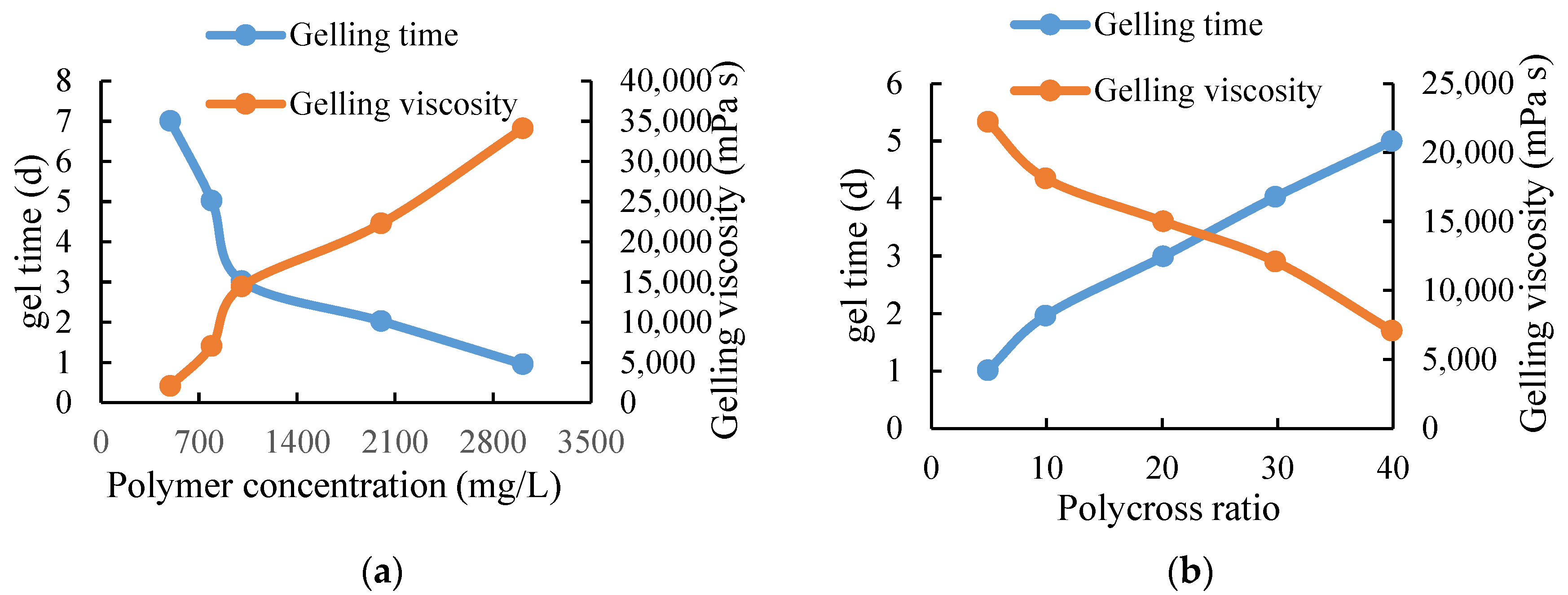
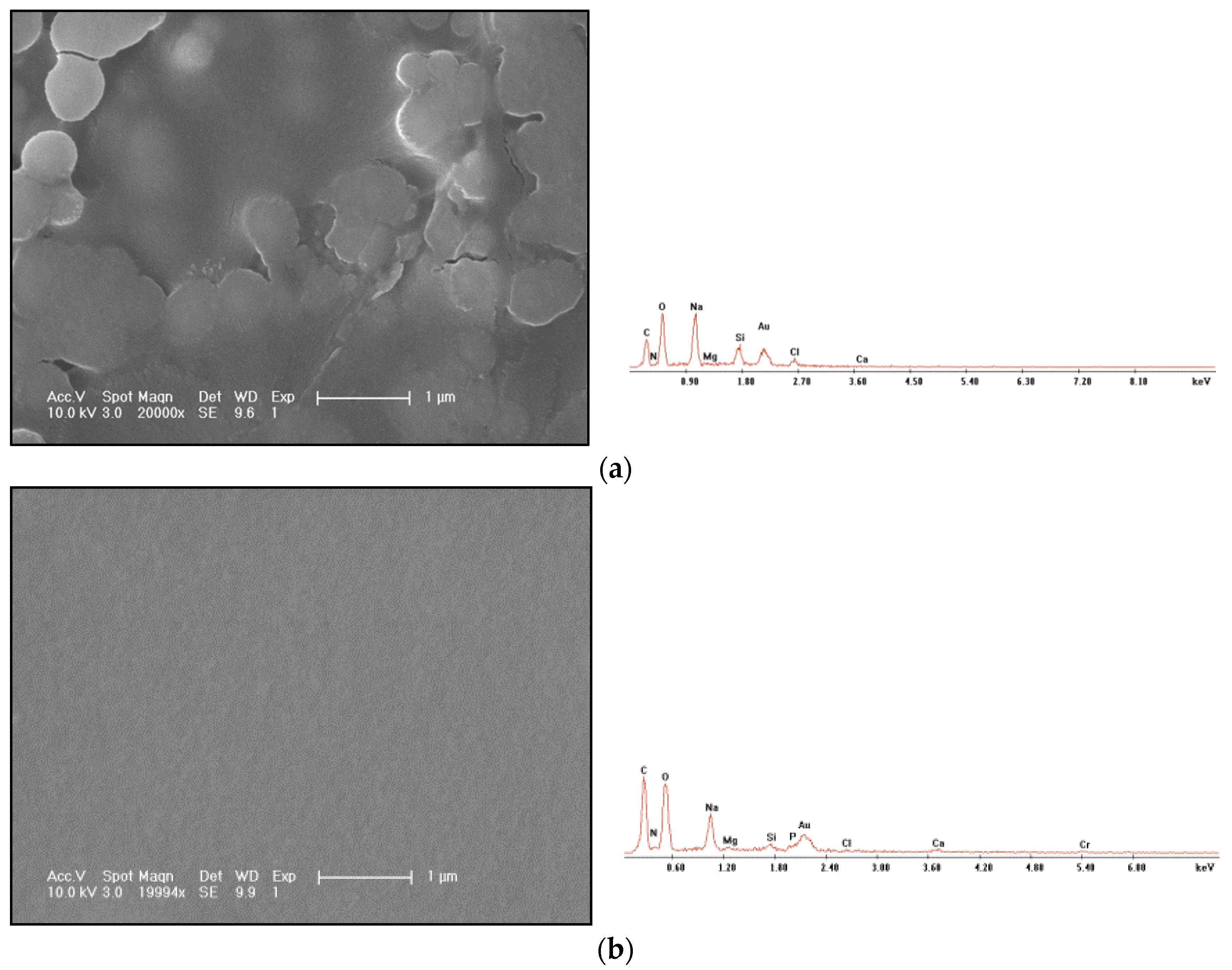
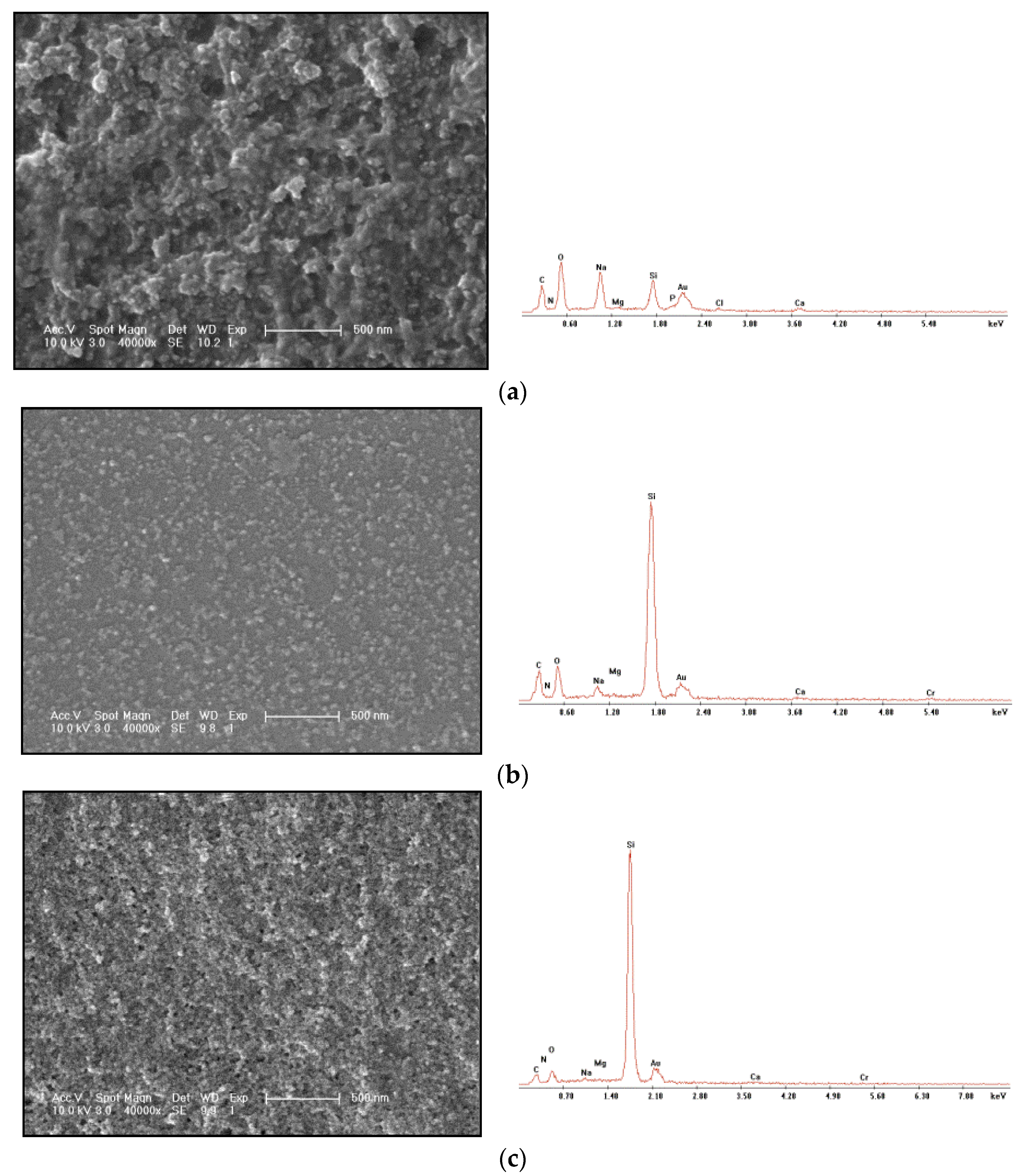

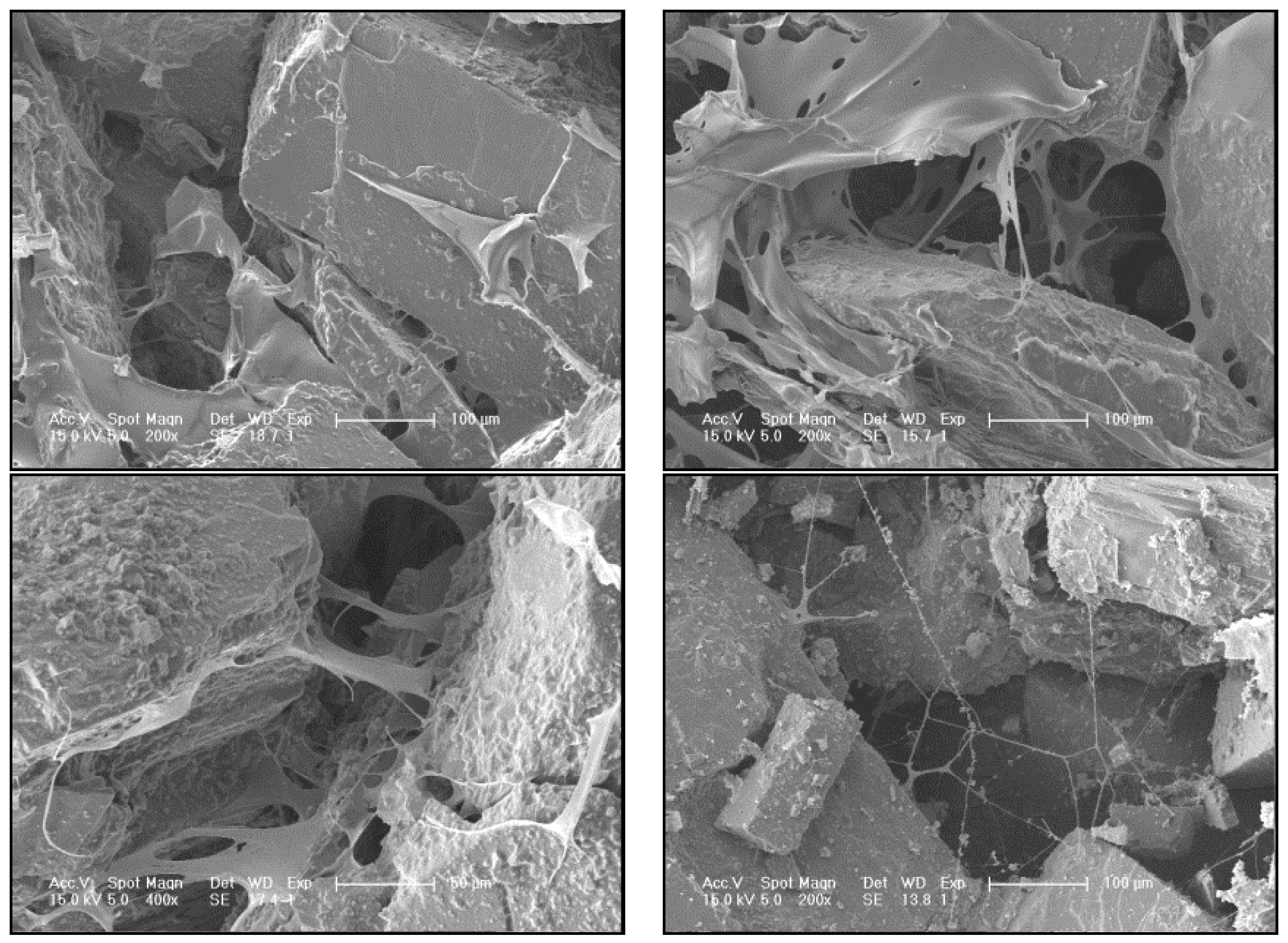
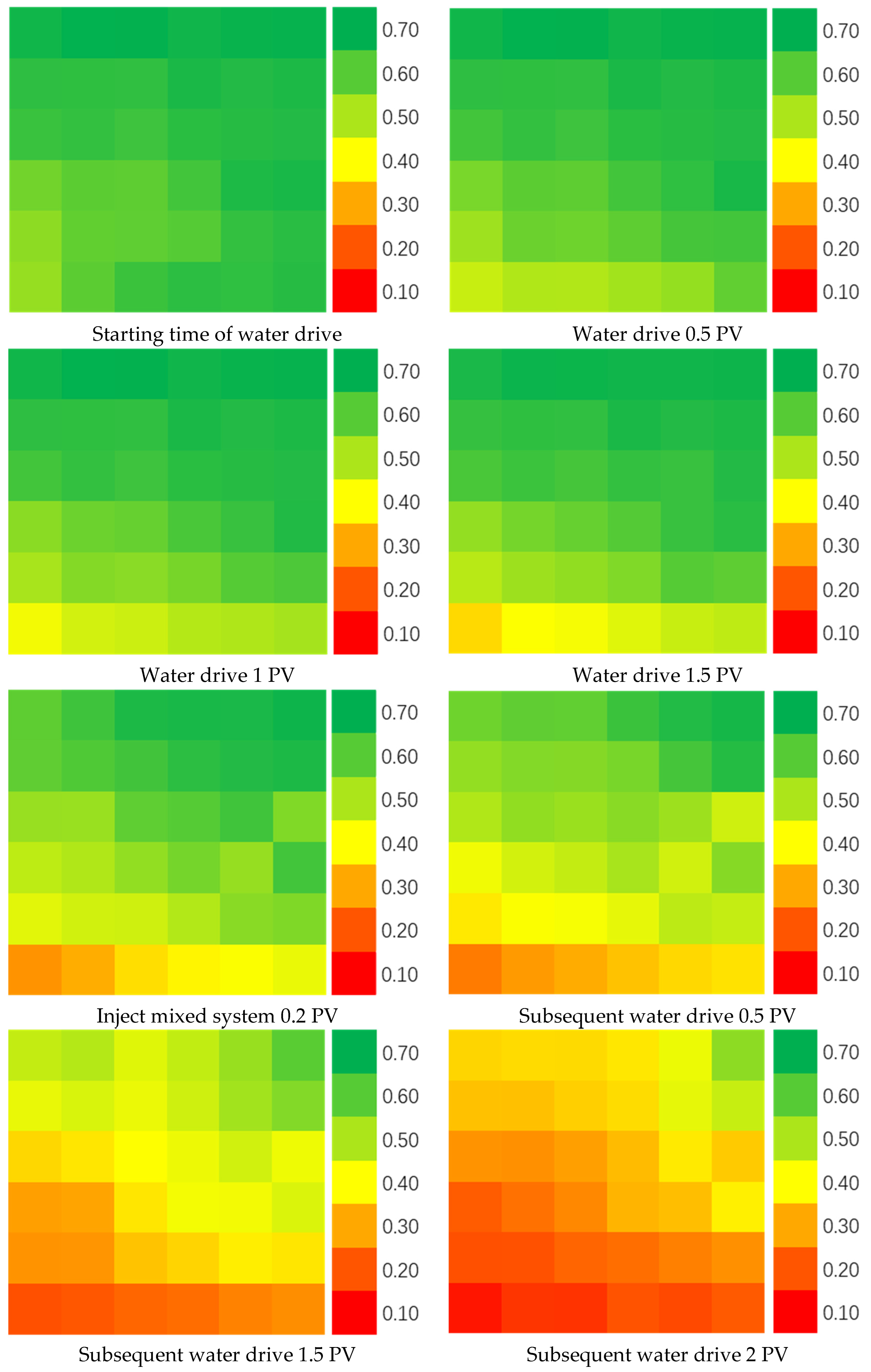
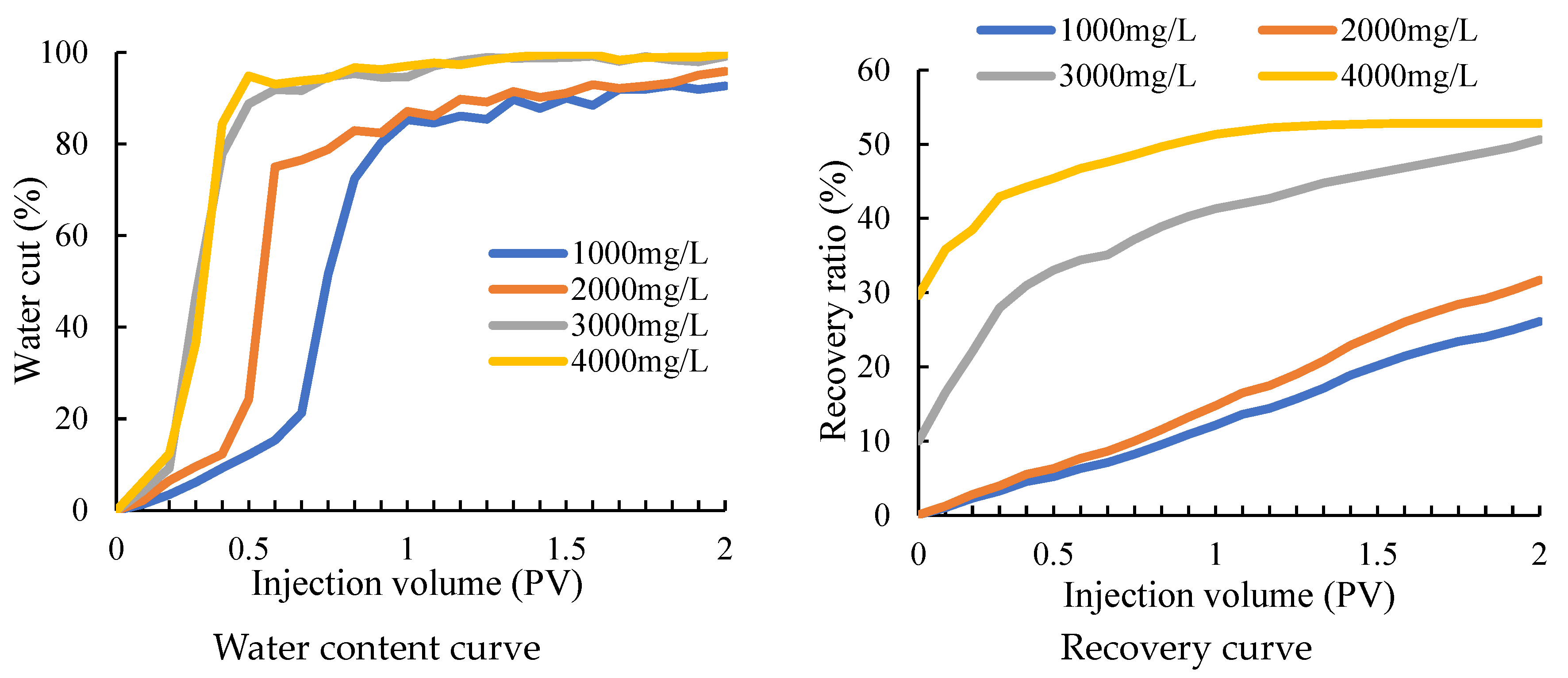
| Serial | Device Name | Specifications | Test Range | Test Accuracy |
|---|---|---|---|---|
| 1 | Electric incubator | HH-W21–600 | 37.0~150.0 °C | ±1.0 °C |
| 2 | Water bath | BX-101 | 25.0~95.0 °C | ±1.0 °C |
| 3 | Hand pump | CY-1 | 0.0~30.0 MPa | ±0.1 MPa |
| 4 | High-pressure metering pump | JB-Ⅲ | 0.0~50.0 MPa | ±0.01 MPa |
| 5 | Electronic balance | JA5003 | 0.0~500.0 g | ±0.001 g |
| 6 | TA rheometer | TA2000EX | ||
| 7 | Low speed mixer | JJ-1 |
| Polymer Concentration (mg/L) | Aggregate Cross Ratio | Gel Time (d) | Branch Water | Produced Water | ||
|---|---|---|---|---|---|---|
| Initial Viscosity (mPa·s) | Gel Viscosity (mPa·s) | Initial Viscosity (mPa·s) | Gel Viscosity (mPa·s) | |||
| 500 | 20:1–40:1 | 1–5 | 11 | 3800 | 6.8 | 3600 |
| 1000 | 20:1–40:1 | 1–5 | 37 | 8000 | 16.2 | 5200 |
| 1500 | 30:1–40:1 | 1–5 | 92 | 20,000 | 31 | 8900 |
| 2000 | 30:1–40:1 | 1–5 | 151 | 22,000 | 50 | 14,000 |
| Number | pH | Polymer Concentration (mg/L) | Aggregate Cross Ratio | Gelling Time (d) | Gelling Viscosity (mPa·s) |
|---|---|---|---|---|---|
| 1 | 6 | 2000 | 30:1 | / | / |
| 2 | 7 | 2000 | 30:1 | 7 | 9000 |
| 3 | 8 | 2000 | 30:1 | 4 | 13,400 |
| 4 | 9 | 2000 | 30:1 | 3 | 14,500 |
| 5 | 10 | 2000 | 30:1 | 1 | 12,000 |
| Polymer Concentration (mg/L) | Gelling Environment (pH) | Surfactant Concentration (%) | Gelling Time (d) | Gelling Viscosity (mPa·s) |
|---|---|---|---|---|
| 1500 | 8~9 | 0.1~0.3 | 1~3 | 7500 |
| 3000 | 8~9 | 0.1~0.3 | 1~3 | 16,000 |
| Number | Polymer Concentration (mg/L) | Cutting Mode | Initial Viscosity (mPa·s) | Viscosity after Shearing (mPa·s) | Gelling Time (d) | Gelling Viscosity (mPa·s) |
|---|---|---|---|---|---|---|
| 1 | 1500 | Uncut | 135 | Uncut | 4 | 8900 |
| 2 | 1500 | Shear | 132 | 93 | 4.5 | 6800 |
| 3 | 2000 | Uncut | 222 | Uncut | 3 | 11,900 |
| 4 | 2000 | Shear | 219 | 131 | 3 | 10,800 |
| 5 | 3000 | Uncut | 354 | Uncut | 2 | 21,900 |
| 6 | 3000 | Shear | 349 | 211 | 2.5 | 20,700 |
| Polymer Concentration (mg/L) | Aggregate Cross Ratio | Viscosity under Different Conditions (mPa·s) | |||||
|---|---|---|---|---|---|---|---|
| Initial Gelling | 10 d | 30 d | 60 d | 90 d | 120 d | ||
| 500 | 30:1 | 1000 | 3600 | 3560 | 3480 | 3410 | 3350 |
| 1000 | 30:1 | 1000 | 5200 | 5150 | 5070 | 4990 | 4920 |
| 1500 | 30:1 | 8900 | 8850 | 8800 | 8600 | 8350 | 8200 |
| 2000 | 30:1 | 12,000 | 11,900 | 11,700 | 11,400 | 11,100 | 10,800 |
| 3000 | 30:1 | 22,400 | 22,300 | 22,100 | 21,900 | 21,200 | 20,400 |
| Polymer Concentration (mg/L) | Aggregate Cross Ratio | Initial Viscosity (mPa·s) | Gelling Time (d) | Gelling Viscosity (mPa·s) | pH | Effective Content (%) | Applicable Temperature (°C) |
|---|---|---|---|---|---|---|---|
| 500 | 30:1 | 10 | 5d | 2685 | 7–9 | 2–4 | 30–60 |
| 1000 | 30:1 | 93 | 4d | 5836 | |||
| 1500 | 30:1 | 135 | 4d | 9037 | |||
| 2000 | 30:1 | 249 | 3d | 12,770 | |||
| 2500 | 30:1 | 309 | 2d | 22,390 | |||
| 3000 | 30:1 | 339 | 2d | 22,640 |
| Core Number | Particle Size (mm) | Overburden Rock Pressure (MPa) | Pressure after Plugging (MPa) | Plugging Rate | Pressure after Scouring (MPa) | Final Plugging Rate |
|---|---|---|---|---|---|---|
| 1 | 0.150–0.250 | 6 | 0.039 | 96.92% | 0.012 | 89.77% |
| 8 | 0.115 | 97.83% | 0.028 | 91.06% | ||
| 10 | 0.165 | 96.42% | 0.075 | 92.15% | ||
| 12 | 1.757 | 99.63% | 0.154 | 95.77% | ||
| 14 | 1.852 | 98.65% | 0.572 | 95.63% | ||
| 2 | 0.250–0.420 | 6 | 0.080 | 98.26% | 0.022 | 93.49% |
| 8 | 0.195 | 98.67% | 0.050 | 94.79% | ||
| 10 | 1.786 | 99.72% | 0.146 | 96.58% | ||
| 12 | 1.523 | 99.56% | 0.316 | 97.88% | ||
| 14 | 0.528 | 95.55% | 0.371 | 93.67% |
Publisher’s Note: MDPI stays neutral with regard to jurisdictional claims in published maps and institutional affiliations. |
© 2022 by the authors. Licensee MDPI, Basel, Switzerland. This article is an open access article distributed under the terms and conditions of the Creative Commons Attribution (CC BY) license (https://creativecommons.org/licenses/by/4.0/).
Share and Cite
Li, T.; Yang, W.; Wu, J.; Xing, P.; Xu, Q.; Liu, H.; Cao, G. Enhanced Retention and Synergistic Plugging Effect of Multi-Complexed Gel on Water-Swellable Rubber. Energies 2022, 15, 8096. https://doi.org/10.3390/en15218096
Li T, Yang W, Wu J, Xing P, Xu Q, Liu H, Cao G. Enhanced Retention and Synergistic Plugging Effect of Multi-Complexed Gel on Water-Swellable Rubber. Energies. 2022; 15(21):8096. https://doi.org/10.3390/en15218096
Chicago/Turabian StyleLi, Tong, Wenwu Yang, Jiajun Wu, Peidong Xing, Qian Xu, Hegao Liu, and Guangsheng Cao. 2022. "Enhanced Retention and Synergistic Plugging Effect of Multi-Complexed Gel on Water-Swellable Rubber" Energies 15, no. 21: 8096. https://doi.org/10.3390/en15218096
APA StyleLi, T., Yang, W., Wu, J., Xing, P., Xu, Q., Liu, H., & Cao, G. (2022). Enhanced Retention and Synergistic Plugging Effect of Multi-Complexed Gel on Water-Swellable Rubber. Energies, 15(21), 8096. https://doi.org/10.3390/en15218096








